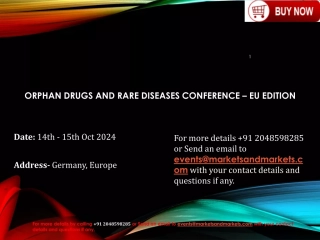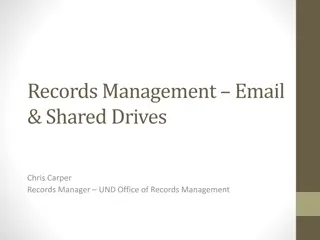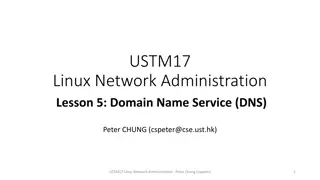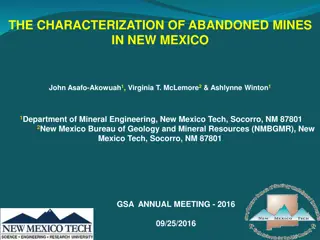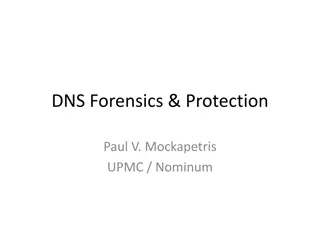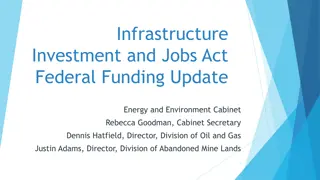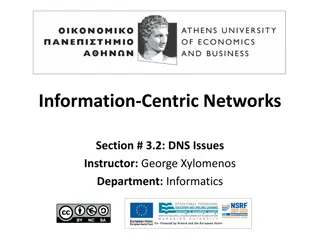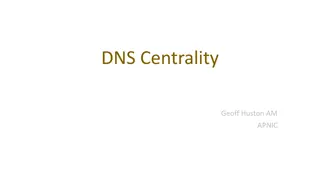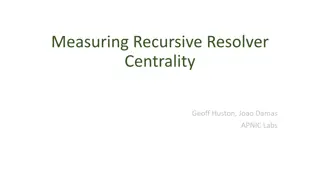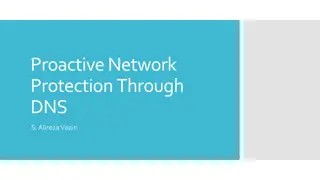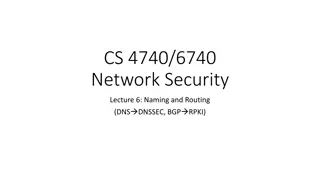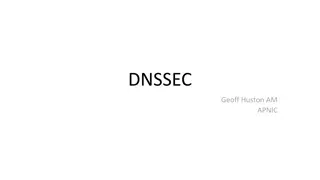The Forgotten Side of DNS: Orphan and Abandoned Records
DNS zone administration can be complex, leading to misconfigurations like orphan and abandoned records. Orphan records are former glue records no longer needed, while abandoned records have related domains but are unnecessary. This analysis extends prior research, examining 2K TLDs over 25 months to understand these issues.
Download Presentation

Please find below an Image/Link to download the presentation.
The content on the website is provided AS IS for your information and personal use only. It may not be sold, licensed, or shared on other websites without obtaining consent from the author.If you encounter any issues during the download, it is possible that the publisher has removed the file from their server.
You are allowed to download the files provided on this website for personal or commercial use, subject to the condition that they are used lawfully. All files are the property of their respective owners.
The content on the website is provided AS IS for your information and personal use only. It may not be sold, licensed, or shared on other websites without obtaining consent from the author.
E N D
Presentation Transcript
The Forgotten Side of DNS: Orphan and Abandoned Records R. Sommese, M. Jonker, R. van Rijswijk-Deij, A. Dainotti, K. Claffy, and A. Sperotto
Introduction DNS zone administration is a complex task involving manual work and several entities. Within the context of the DNS, we typically identify three types of stakeholders: registries, registrars, and registrants. Due to the complexity of managing DNS information, misconfiguration and errors can occur, with an impact on the overall security and reachability of the DNS. In this work, we present an analysis on a specific misconfiguration, defined as orphan records.
Glue Records A top-level domain (TLD) is a special type of zone that typically only has one task: to delegate authority for second-level domains. The delegation uses NS records that identify the name server for a domain. If the NS record for a domain points to a record that is inside the domain (called in-bailiwick), that name is included in the zone as a glue record to enable the resolution process to continue. Glue records are usually the only A/AAAA records admitted to TLD zone files.
A Well-Formed Zone In normal operation, glue records are used only to break the circular dependency in the process of the resolution. good.com ns1.good.com 3600 IN A 1.2.3.5 86400 IN NS ns1.good.com
Orphan Records? An orphan record is a former glue record for which the related domain no longer exists in the zone (the delegation has been removed) These records are supposed to be removed after a delegation is removed or changed.
Orphan Records: A Decade Later This work reproduces and extends the analysis performed by Kalafut et al. in 2010. A decade after the original analysis, what does the orphan records phenomenon look like? We characterize the orphan records through a dataset of 2K TLDs and over a wider time window of 25 months. We also discover a related type of misconfiguration, which we call "Abandoned Records".
Abandoned Records? We define abandoned record as a former glue record for which the related domain still exists in the zone, but the delegation no longer requires that glue record. Abandoned records do not show up in the DNS resolution. They are returned in the additional section only when they are referred by a delegation of other domains of the zone.
Orphan Records Abandoned Records A QUICK RECAP
Results We found 88K orphan and 1M abandoned records (daily average). The .info zone is responsible for ~44K orphans and shows the highest percentage of orphans over the total number of records in the zone. We found many orphans also in .org and new gTLDs. Abandoned records are most prevalent in .com and .org.
Orphan and Abandoned Records Lifetime For Orphan records, we found that ~19% survive just one day. However 4% (21640) of all the orphan records we found persisted for more than 760 days. These 21640 orphans represent the hard core of orphan records in zone files, proving that this is a long-term misconfiguration. Same considerations apply to abandoned records, with the exception that, on average, abandoned survive longer.
What's the Harm? Orphan records are working A DNS records that can still be in use. They can be referred by other domains as NS records (in case of legitimate usage) or they can host malicious content (e.g. malicious website). Registries should remove these records, or at least forbid the registration of the parent domain. An attacker, indeed, could potentially register the parent domain and hijack the orphan record traffic. All the domains that point to that orphan as NS will then be Hijacked!
DOMAIN POTENTIALLY HIJACKABLE
Abandoned, not harmful? While the security risks related to orphan records are clear, Abandoned records, at first look, are instead not harmful. They can not be exploited by registering the domain, because the domain exists. However, we discover a relationship between orphan and abandoned. ~28% of orphan records were previously abandoned records. ~2% of orphans become abandoned Evidence of registered Orphans!
EPP and Orphan records Orphan and abandoned records come to exist due to how EPP (Extensible Provisioning Protocol) communication between registry and registrar takes place. EPP defines three main object types: domains (NS records), contacts, and hosts (the glue records). In EPP, the creation of host and domain resources are two independent operations. The EPP specification does not define who, between registry and registrar, is responsible to clean up glue records if they are no longer required. This leads to the creation of orphan records.
Registry, Registrar: Take action In 2010, Verisign cleans up .com and .net zone file removing all the orphan records. Still, after 10 years, some TLDs are been affected by the orphan records misconfiguration. The problem was also addressed by ICANN Security and Stability Committee in 2010 (SAC 048) We advise TLDs to revise their EPP policies and implementations and to clean up their zone
Afilias Case We reached out to Afilias, which is responsible for the technical management of .info, .org and many other TLDs affected by the orphan's misconfiguration. They are in the process of taking action for removing orphan records from their zone. http://www.circleid.com/posts/20200811-afilias-to-protect-tlds-against- potential-orphan-glue-exploits
Conclusion Orphan records revealed to be a long term misconfiguration of the DNS TLD zones. After a decade from the original study, orphan records are still there. We extended scope and the scale of previous work and also discovered "abandoned records" that can be considered as a ringing bell of the creation of orphans. We invite all the registry to act to prevent the creation of these records.


